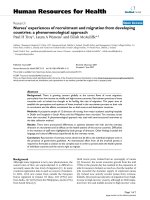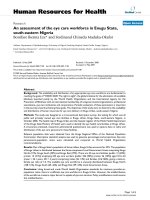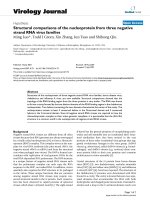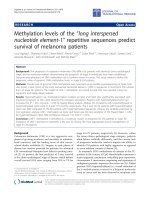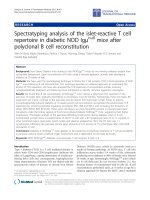Báo cáo sinh học: "Chromosomal assignment of the genetic factor, tu-91k, responsible for a melanotic tumour in the Drosophila melanogaster adult female" pptx
Bạn đang xem bản rút gọn của tài liệu. Xem và tải ngay bản đầy đủ của tài liệu tại đây (477.51 KB, 5 trang )
Note
Chromosomal
assignment
of
the
genetic
factor,
tu-91k,
responsible
for
a
melanotic
tumour
in
the
Drosophila
melanogaster
adult
female
K
Kosuda
Josai
University,
Faculty
of Science,
Biological
Laboratory,
Sakado,
Saitaraa
350-02,
Japan
(Received
3
March
1992;
accepted
5
August
1992)
Summary -
Chromosomal
transfer
experiments
were
carried
out
to
assign
tu-91k,
the
genetic
factor
responsible
for
the
organ-specific
and
female-limited
adult
melanotic
tumour
in
Drosophila
melanogaster.
It
was
found
that
the
second
chromosome
has
a
predominant
effect
and
tu-91k
is
semidominant
in
its
phenotypic
expression.
melanotic
tumour
/
Drosophila
melanogaster
/
chromosome
assignment
/
semi-
dominance
Résumé -
Assignation
chromosomique
du
facteur
génétique
tu-91k,
responsable
du
développement
d’une
tumeur
mélanique
chez
la
femelle
de
Drosophila
melanogaster.
Des
expériences
de
transfert
chromosomique
ont
été
réalisées
en
vue
d’assigner
le facteur
génétique
tu-91k,
responsable
d’une
tumeur
mélanique
spécifique
d’un
organe
et
limitée
à
la
femelle
adulte
de
Drosophila
melanogaster.
Il
a
été
trouvé
que
le
deuxième
chromosome
a
un
effet
prédominant
et
que
tu-91k
est
semi-dominant
dans
son
ezpression
phénotypique.
tumeur
mélanique
/
Drosophila
melanogaster
/
assignation
chromosomique
/
semi-
dominance
INTRODUCTION
Many
different
melanotic
tumour
strains
have
been
described
in
Drosophila
and
other
insects
since
Bridges
(1916)
first
reported
one
in
Drosophila
melanogaster,
but
only
in
a
rather
small
portion
have
the
tumour
genes
been
analysed
in
detail
(Gateff
1978,
1982;
Sparrow,
1978).
Many
of
the
difficulties
of
analysing
melanotic
tumour
mutants
stem
from
the
fact
that
the
phenotype
is
very
variable
and
they
often
have
low
penetrance.
In
previous
papers,
Kosuda
(1990,
1991)
reported
a
new
melanotic
tumour
strain,
C-104,
in
D
melanogaster,
in
which
the
penetrance
is
rather
high.
The
tumour
in
the
C-104
strain
has
several
unique
characteristics
(Kosuda,
1991).
As
this
melanotic
tumour
develops
at
an
adult
stage,
whereas
most
other
tumours
appear
in
larval
stages,
especially
in
the
3rd
instar
larvae
shortly
before
pupation,
this
tumour
can
be
classified
as
an
adult
one.
It
can
only
be
detected
under
the
microscope
in
female
flies,
especially
in
the
vicinity
of
the
spermathecae.
In
other
words,
its
expression
is
sex-limited
and
organ-specific.
Tumours
often
become
macroscopically
visible
as
dense
black
bodies
within the
abdominal
cavity
when
they
fully
develop.
The
incidence
of
tumour
development
was
shown
to
increase
with
age
(Kosuda,
1990).
To
test
the
role
of
major
chromosomes
of
D
melanogaster
in
the
development
of
melanotic
tumours,
chromosomal
transfer
experiments
were
carried
out
in
the
present
study.
MATERIALS
AND
METHODS
The
melanotic
tumour
strain
C-104,
used
in
this
study
is
a
highly
inbred
one
and
is
derived
from
a
natural
population
in
Budapest,
Hungary.
The
2
major
autosomes
and
the
X
chromosome
of
the
C-104
strain
were
independently
made
homozygous
by
a
routine
procedure
utilizing
&dquo;balancer&dquo;
chromosomes.
Complicated
inversions
contained
in
these
balancer
chromosomes
prevent
re-
combination
between
the
homologous
chromosomes,
and
thus
preserve
the
original
genetic
content
of
the
chromosome
in
the
C-104
strain.
Second
and
third
chromo-
somes
were
marked
with
Cy
In
(2LR)
CyL/Prrc
and
with
In
(3LR)
TM3
!76a;/6’6,
respectively.
The
sex
chromosome
was
also
marked
with
the
Muller-5
chromosome.
The
mating
scheme
is
presented
in
figure
1.
Female
flies
homozygous
for
respective
chromosomes
were
maintained
for
2
wk
at
29°C
to
facilitate
ageing,
by
transferring
these
flies
to
fresh
vials
containing
standard
cornmeal
yeast
media
every
2
or
3
d.
After
2
wk,
female
flies
were
singly
dissected
in
Ringer
solution
for
Drosophila
under
the
microscope
and
were
examined
under
the
microscope
for
presence
or
absence
of
melanotic
tumours
in
the
vicinity
of
both
spermathecae
(figs
2a,b,c).
RESULTS
AND
DISCUSSION
Numerical
results
are
given
in
table
I.
The
principal
genetic
factor
causing
melanotic
tumours
in
the
aged
females
is
located
on
the
second
chromosome,
as
is
explicitly
shown
in
table
I.
The
genetic
factor
responsible
for
the
development
of
female
specific
melanotic
tumours
in
the
C-104
strain
is
designated
tu!-91k.
The
3rd
chromosome
and
X
chromosome
are
apparently
not
involved
in
the
expression
of
the
melanotic
tumour
development
in
the
C-104
strain.
It
is
possible
that
modifier
loci
are
involved
on
other
than
the
second
chromosome,
as
the
genetic
control
of
other
melanotic
tumours
has
generally
been
found
to
be
multifactorial
(Barigozzi
et
al 1960;
Burnet
and
Sang,
1964;
Mampell,
1967;
Lindsley
and
Grell,
1968;
Belt
and
Burnet,
1972;
Sparrow,
1974,
1978).
It
seems
evident
that
the
presence
of
a
second
chromosome
from
the
C-104
strain
alone
is
sufficient
to
induce
melanotic
tumour
formation,
since
the
proportion
of
flies
carrying
melanotic
tumours
among
those
homozygous
for
the
second
chromosome
is
not
less
than
that
in
the
original
C-104
strain
as
reported
in
Kosuda
(1990),
although
reduction
in
the
phenotypic
expression
is
usually
expected
in
such
crosses
owing
to
changes
in
the
genetic
background.
The
heterozygous
effect
of
tu-91k
on
the
expression
of
this
organ-specific
and
female-limited
adult
melanotic
tumour
was
also
studied
using
3-wk-old
female
flies.
The
tu-91k
heterozygous
females
were
obtained
by
crosses
between
the
C-104
strain
and
Cy
In
(2LR)CyL
Pm
or
Carton -
S
strain.
The
results
are
summarized
in
table
II.
Ratios
I
and
II
showing
the
proportion
of
melanotic
tumour-
developing
females
or
spermathecae
in
heterozygous
females
are
0.179
and
0.095
on
the
average,
respectively.
On
the
other
hand,
ratios
I
and
II
in
homozygotes
are
0.281
and
0.186,
respectively.
Since
these
figures
in
heterozygous
females
are
almost
half
of
those
in
homozygotes,
tu-91k
seems
to
be
semi-dominant.
In
other
words,
the
degree
of
dominance
(h)
seems
to
be
nearly
0.5.
The
present
results
confirm
that
the
melanotic
tumour
development
in
the
C-104
strain
of
D
melanogaster
is
genetically
controlled
and
the
hereditary
mode
is
relatively
simple
and
the
second
chromosome
has
a
predominant
effect.
The
major
gene
responsible
for
this
melanotic
tumour
mutation
on
the
second
chromosome
is
named
tu-91k.
It
should
be
noted
that
the
tu-91k
gene
is
not
recessive
as
are
other
melanotic
tumour
mutant
genes
but
its
phenotypic
expression
is
semi-dominant.
Barigozzi
C,
Castiglioni
MC,
DiPasquale
A
(1960)
A
complex
genotype
controlling
the
production
of
melanotic
tumors
(pseudotumors)
in
Drosophila.
Heredity
14,
151-162
Belt
AL,
Burnet
B
(1972)
Experimental
modification
of
the
dominance
relations
of
a
melanotic
tumor
gene
in
Drosophila
melanogaster.
Genet
Res
20,
115-135
Bridges
CB
(1916)
Non-disjunction
as
a
proof
of
the
chromosome
theory
of
inheritance.
Genetics
1,
1-52
Burnet
B,
Sang
JH
(1964)
Physiological
genetics
of
melanotic
tumors
in
Drosophila
melanogaster.
II.
The
genetic
basis
of
response
to
tumorigenic
treatment
in
the
tu
and
tu
bw;
st
su-tu
strains.
Genetics
49,
223-245
Gateff
E
(1978)
Malignant
and
benign
neoplasms
of
Drosophila
melanogaster.
In:
The
Genetics
and
Biology
of Drosophila
(Ashburner
M,
Wright
TRF,
eds)
Academic
Press,
London,
vol
2b,
181-276
Gateff
E
(1982)
Cancer,
gene
and
development:
the
Drosophila
case.
Adv
Cancer
Res
37,
33-74
Kosuda
K
(1990)
Ageing
and
temperature
effects
on
tumour
development
in
Drosophila
melanogaster.
Gerontology
36,
121-125
Kosuda
K
(1991)
The
tumour
formation
in
Drosophila
melanogaster
females.
Dros
Inf
Serv
90,
123-124
Lindsley
DL,
Grell
EH
(1968)
Genetic
Variation
of
Drosophila
melanogaster.
Carnegie
Institution,
Washington
Mampell
K
(1967)
Genetics
and
environmental
control
of
melanotic
tumours
in
Drosophila.
Genetica
37,
449-465
Sparrow
JC
(1974)
The
genetics
of
some
second
chromosome
melanotic
tumour
mutants
of
Drosophila
melanogaster.
Genet
Res
23,
13-21
Sparrow
JC
(1978)
Melanotic
tumours.
In:
The
Genetics
and
Biology
of Drosophila
(Ashburner
M,
Wright
TRF,
eds)
Academic
Press,
London,
vol
2b,
277-313


